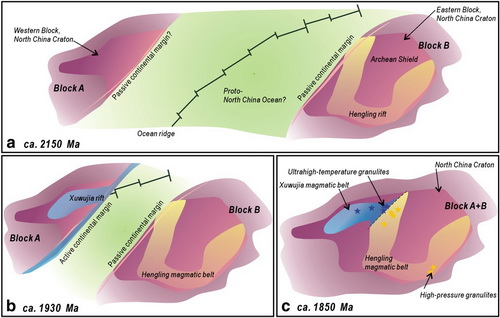Genesis of the Hengling magmatic belt in the North China Craton: Implications for Paleoproterozoic tectonicsUpdate time:09 17, 2012
Vice Professor PENG Peng and his team present new geochemical and isotopic age data on several generations of 2200-1880 Ma dykes/sills, and propose that they occur in a Paleoproterozoic intracontinental rift within a newly-defined coeval magmatic belt. This new information should help in understanding and unraveling the complex framework and evolution of this classic craton. The 2200–1880 Ma igneous rocks in the central and eastern parts of the North China Craton (NCC) constitute a new Hengling magmatic belt (HMB), which includes the ~2147 Ma Hengling mafic sill/dyke swarm, the ~2060 Ma Yixingzhai mafic dyke swarm, and the ~1973 Ma Xiwangshan mafic dyke swarm. The 2200–1880 Ma igneous rocks in the central and eastern parts of the North China Craton (NCC) constitute a new Hengling magmatic belt (HMB), which includes the ~2147 Ma Hengling mafic sill/dyke swarm, the ~2060 Ma Yixingzhai mafic dyke swarm, and the ~1973 Ma Xiwangshan mafic dyke swarm. The progressive changing compositions of the three swarms are interpreted in terms of their source regions at different depths, i.e., shallower and shallower through time. And the decrease in scale and size of the intrusions and their magma volumes indicate the progressive weakening of magmatism in this rift.
Fig. 1. Distribution of 2200–1880 Ma igneous rocks in the North China Craton. (Image by PENG)
Fig. 2. Cartoons showing the proposed geological scenario and tectonic model of the North China Craton. (Image by PENG) Peng et al. Genesis of the Hengling magmatic belt in the North China Craton: Implications for Paleoproterozoic tectonics. Lithos. 2012, 148: 27-44(DownloadHere)
|
Contact
Related Articles
Reference
|
-
SIMSSecondary Ion Mass Spectrometer Laboratory
-
MC-ICPMSMultiple-collector ICPMS Laboratory
-
EM & TEMElectron Microprobe and Transmission Electron Microscope Laboratory
-
SISolid Isotope Laboratory
-
StIStable Isotope Laboratory
-
RMPARock-Mineral Preparation and Analysis
-
AAH40Ar/39Ar & (U-Th)/He Laboratory
-
EMLElectron Microscopy Laboratory
-
USCLUranium Series Chronology Laboratory
-
SASeismic Array Laboratory
-
SEELaboratory of Space Environment Exploration Laboratory
-
PGPaleomagnetism and Geochronology Laboratory
-
BioMNSFrance-China Bio-mineralization and Nano-structure Laboratory

 Print
Print Close
Close

